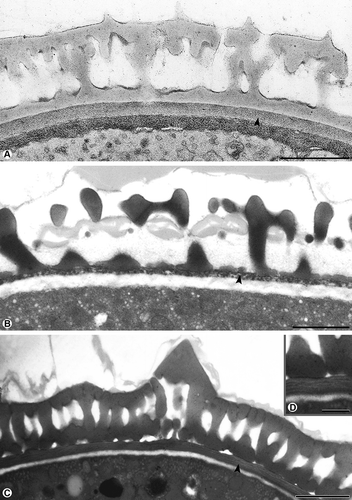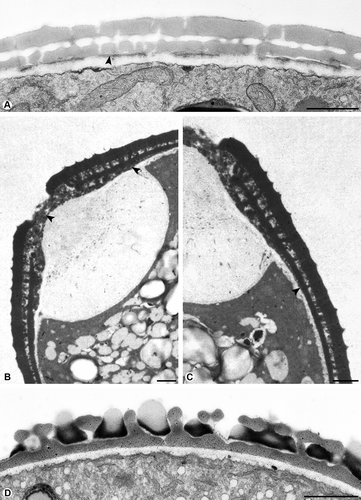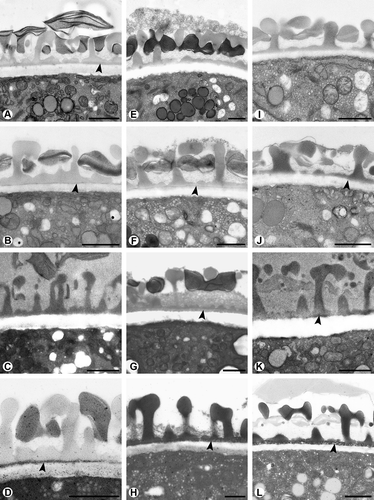Figures & data
Figure 1. Cross-section of pollen walls showing three types of continuous endexines. A. Compact: Galium odoratum, the compact endexine (arrowhead) forms a continuous layer, the endexine is electron-dense with the Thiéry-test. B. Spongy: Thymus odoratissimus, the spongy endexine (arrowhead) forms a continuous layer, the endexine stains electron-dense with KMnO4. C, D. Lamellar: Ambrosia artemisiifolia, the lamellar endexine forms a continuous layer, the endexine is electron-dense with KMnO4 (arrowhead), only the lamellae are electron-lucent (D). Scale bars – 1 μm (A–C), 0.5 μm (D).

Figure 2. Cross-section of pollen walls. A. Plantago maritime, the compact endexine (arrowhead) forms a discontinuous layer, the endexine stains electron-dense with modified Thiéry-test. B. Corylus avellana, the spongy endexine is present in the aperture only (arrowhead), the endexine is electron-dense with KMnO4. C. Corylus avellana, the pollen wall at the transition zone of the aperture and interapertural area, a thick endexine in the aperture, very thin at the transition zone (arrowhead), the endexine is absent in the interapertural area, stained with KMnO4. D. Pseudolysimachion spicatum, the endexine is absent, stained with TCH+SP (lipid test). Scale bars – 1 μm.

Table 1. Endexine types and examples
Table 2. Staining behaviour of the endexine
Figure 3. Cross-sections of pollen walls of three Lamiaceae species stained with different methods. Endexine spongy, continuous. A–D. Melissa officinalis: A. Endexine (arrowhead) not clearly visible with modified Thiéry-test; B. Endexine (arrowhead) electron-dense with U + Pb; C. Endexine not visible with TCH + SP (lipid test); D. Endexine (arrowhead) electron-dense with KMnO4. E–H. Mentha aquatica: E. Endexine not visible with modified Thiéry-test; F. Endexine electron-dense with U + Pb; G. Endexine (arrowhead) electron-dense with TCH + SP (lipid test); H. Endexine clearly visible, electron-dense with KMnO4 staining (arrowhead). I–L. Thymus odoratissimus: I. Endexine not visible with modified Thiéry-test; J. Endexine (arrowhead) not clearly visible with U + Pb; K. Endexine (arrowhead) only partially visible with TCH + SP (lipid test); L. Endexine (arrowhead) electron-dense with KMnO4. Scale bars – 1 μm.
